warning VAUXHALL ANTARA 2015 User Guide
[x] Cancel search | Manufacturer: VAUXHALL, Model Year: 2015, Model line: ANTARA, Model: VAUXHALL ANTARA 2015Pages: 223, PDF Size: 6.07 MB
Page 29 of 223
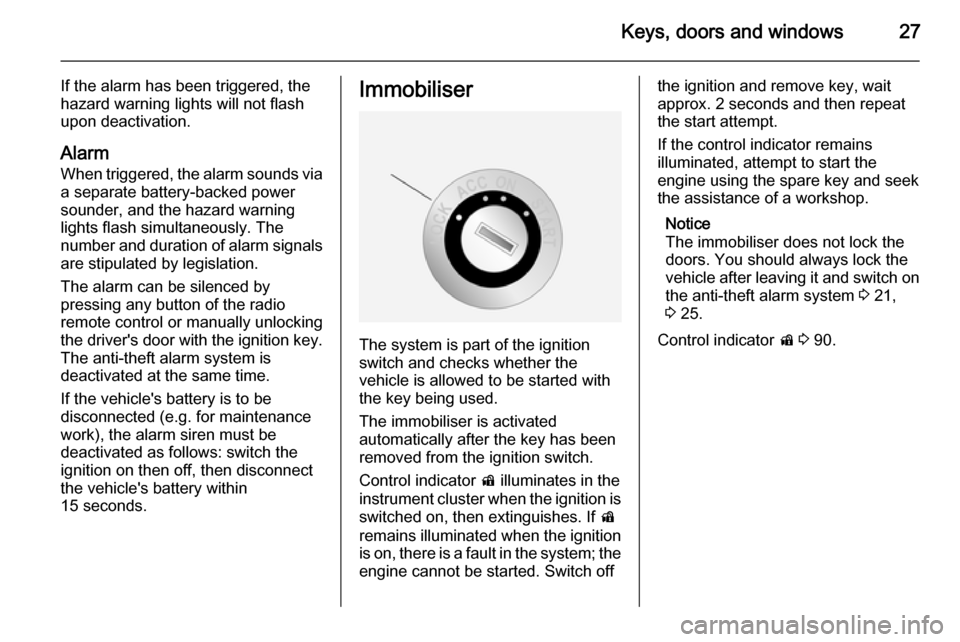
Keys, doors and windows27
If the alarm has been triggered, the
hazard warning lights will not flash
upon deactivation.
Alarm When triggered, the alarm sounds via a separate battery-backed power
sounder, and the hazard warning
lights flash simultaneously. The
number and duration of alarm signals
are stipulated by legislation.
The alarm can be silenced by
pressing any button of the radio
remote control or manually unlocking
the driver's door with the ignition key. The anti-theft alarm system is
deactivated at the same time.
If the vehicle's battery is to be
disconnected (e.g. for maintenance
work), the alarm siren must be
deactivated as follows: switch the
ignition on then off, then disconnect
the vehicle's battery within
15 seconds.Immobiliser
The system is part of the ignition
switch and checks whether the
vehicle is allowed to be started with the key being used.
The immobiliser is activated
automatically after the key has been
removed from the ignition switch.
Control indicator d illuminates in the
instrument cluster when the ignition is switched on, then extinguishes. If d
remains illuminated when the ignition
is on, there is a fault in the system; the
engine cannot be started. Switch off
the ignition and remove key, wait
approx. 2 seconds and then repeat
the start attempt.
If the control indicator remains
illuminated, attempt to start the
engine using the spare key and seek
the assistance of a workshop.
Notice
The immobiliser does not lock the
doors. You should always lock the
vehicle after leaving it and switch on the anti-theft alarm system 3 21,
3 25.
Control indicator d 3 90.
Page 32 of 223
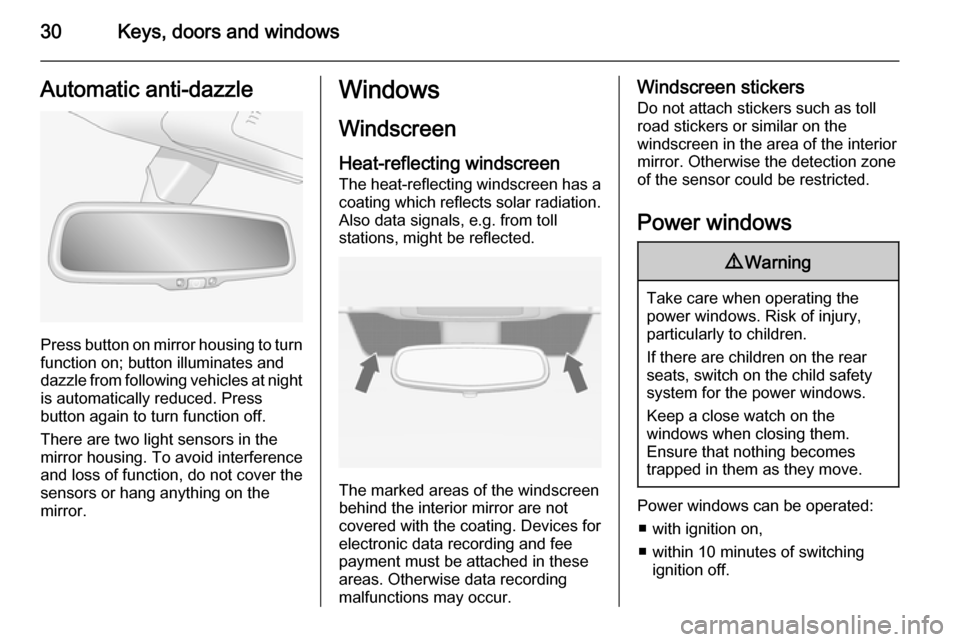
30Keys, doors and windowsAutomatic anti-dazzle
Press button on mirror housing to turn
function on; button illuminates and
dazzle from following vehicles at night
is automatically reduced. Press
button again to turn function off.
There are two light sensors in the
mirror housing. To avoid interference
and loss of function, do not cover the
sensors or hang anything on the mirror.
Windows
Windscreen
Heat-reflecting windscreen The heat-reflecting windscreen has a
coating which reflects solar radiation.
Also data signals, e.g. from toll
stations, might be reflected.
The marked areas of the windscreen
behind the interior mirror are not
covered with the coating. Devices for
electronic data recording and fee
payment must be attached in these
areas. Otherwise data recording
malfunctions may occur.
Windscreen stickers
Do not attach stickers such as toll
road stickers or similar on the
windscreen in the area of the interior
mirror. Otherwise the detection zone
of the sensor could be restricted.
Power windows9 Warning
Take care when operating the
power windows. Risk of injury,
particularly to children.
If there are children on the rear seats, switch on the child safety
system for the power windows.
Keep a close watch on the
windows when closing them.
Ensure that nothing becomes
trapped in them as they move.
Power windows can be operated:
■ with ignition on,
■ within 10 minutes of switching ignition off.
Page 34 of 223
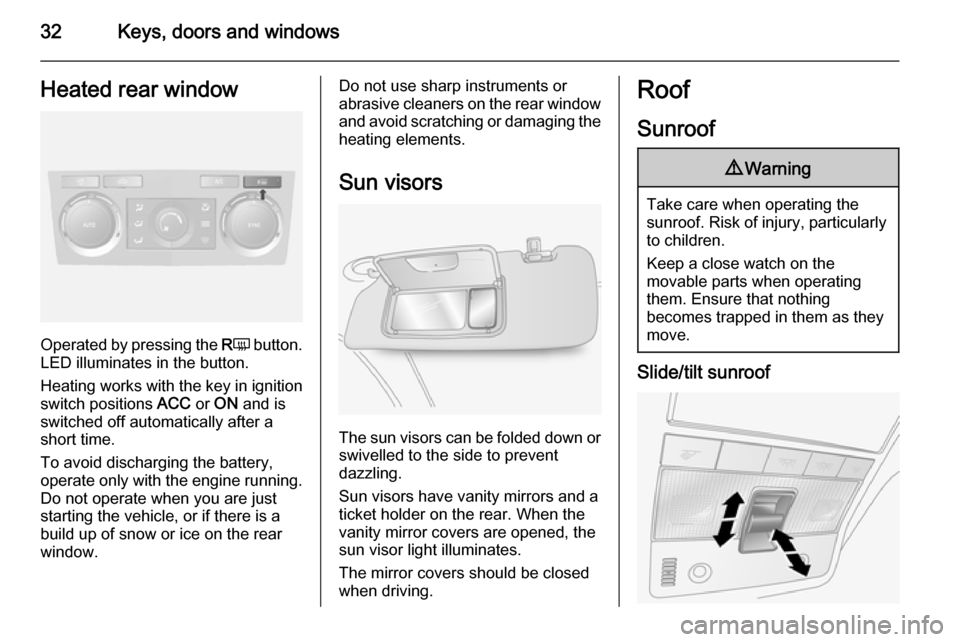
32Keys, doors and windowsHeated rear window
Operated by pressing the RÜ button.
LED illuminates in the button.
Heating works with the key in ignition
switch positions ACC or ON and is
switched off automatically after a
short time.
To avoid discharging the battery, operate only with the engine running. Do not operate when you are juststarting the vehicle, or if there is a
build up of snow or ice on the rear
window.
Do not use sharp instruments or abrasive cleaners on the rear window
and avoid scratching or damaging the
heating elements.
Sun visors
The sun visors can be folded down or swivelled to the side to prevent
dazzling.
Sun visors have vanity mirrors and a
ticket holder on the rear. When the
vanity mirror covers are opened, the
sun visor light illuminates.
The mirror covers should be closed
when driving.
Roof
Sunroof9 Warning
Take care when operating the
sunroof. Risk of injury, particularly to children.
Keep a close watch on the
movable parts when operating
them. Ensure that nothing
becomes trapped in them as they
move.
Slide/tilt sunroof
Page 36 of 223
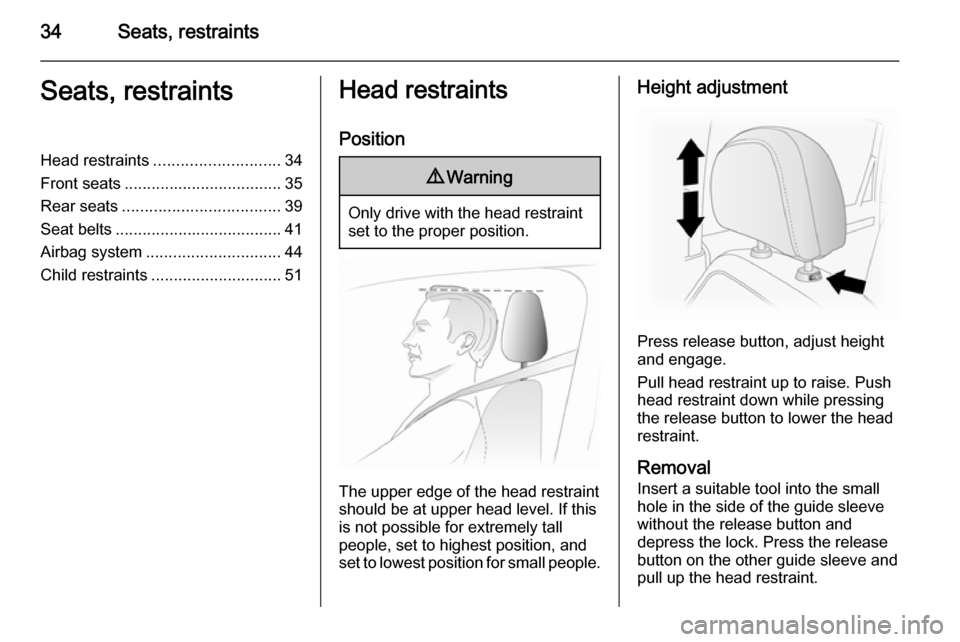
34Seats, restraintsSeats, restraintsHead restraints............................ 34
Front seats ................................... 35
Rear seats ................................... 39
Seat belts ..................................... 41
Airbag system .............................. 44
Child restraints ............................. 51Head restraints
Position9 Warning
Only drive with the head restraint
set to the proper position.
The upper edge of the head restraint
should be at upper head level. If this
is not possible for extremely tall
people, set to highest position, and
set to lowest position for small people.
Height adjustment
Press release button, adjust height
and engage.
Pull head restraint up to raise. Push
head restraint down while pressing
the release button to lower the head
restraint.
Removal
Insert a suitable tool into the small
hole in the side of the guide sleeve
without the release button and
depress the lock. Press the release
button on the other guide sleeve and
pull up the head restraint.
Page 37 of 223
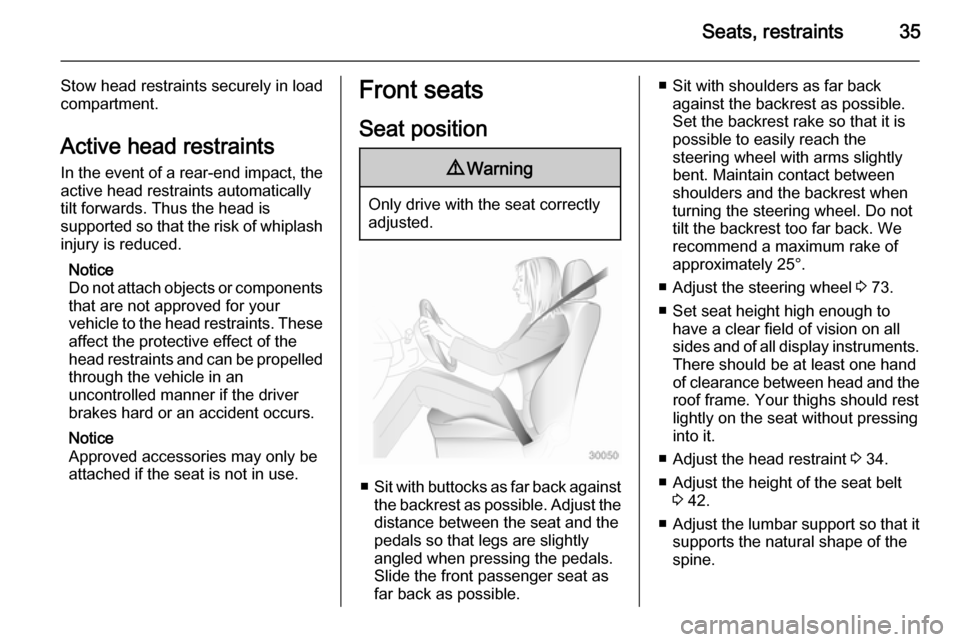
Seats, restraints35
Stow head restraints securely in load
compartment.
Active head restraints
In the event of a rear-end impact, the active head restraints automatically
tilt forwards. Thus the head is
supported so that the risk of whiplash
injury is reduced.
Notice
Do not attach objects or components
that are not approved for your
vehicle to the head restraints. These affect the protective effect of the
head restraints and can be propelled
through the vehicle in an
uncontrolled manner if the driver
brakes hard or an accident occurs.
Notice
Approved accessories may only be
attached if the seat is not in use.Front seats
Seat position9 Warning
Only drive with the seat correctly
adjusted.
■ Sit with buttocks as far back against
the backrest as possible. Adjust the distance between the seat and the
pedals so that legs are slightly
angled when pressing the pedals.
Slide the front passenger seat as
far back as possible.
■ Sit with shoulders as far back against the backrest as possible.
Set the backrest rake so that it is possible to easily reach the
steering wheel with arms slightly bent. Maintain contact between
shoulders and the backrest when
turning the steering wheel. Do not
tilt the backrest too far back. We
recommend a maximum rake of
approximately 25°.
■ Adjust the steering wheel 3 73.
■ Set seat height high enough to have a clear field of vision on allsides and of all display instruments. There should be at least one hand
of clearance between head and the
roof frame. Your thighs should rest
lightly on the seat without pressing
into it.
■ Adjust the head restraint 3 34.
■ Adjust the height of the seat belt 3 42.
■ Adjust the lumbar support so that it
supports the natural shape of the
spine.
Page 38 of 223
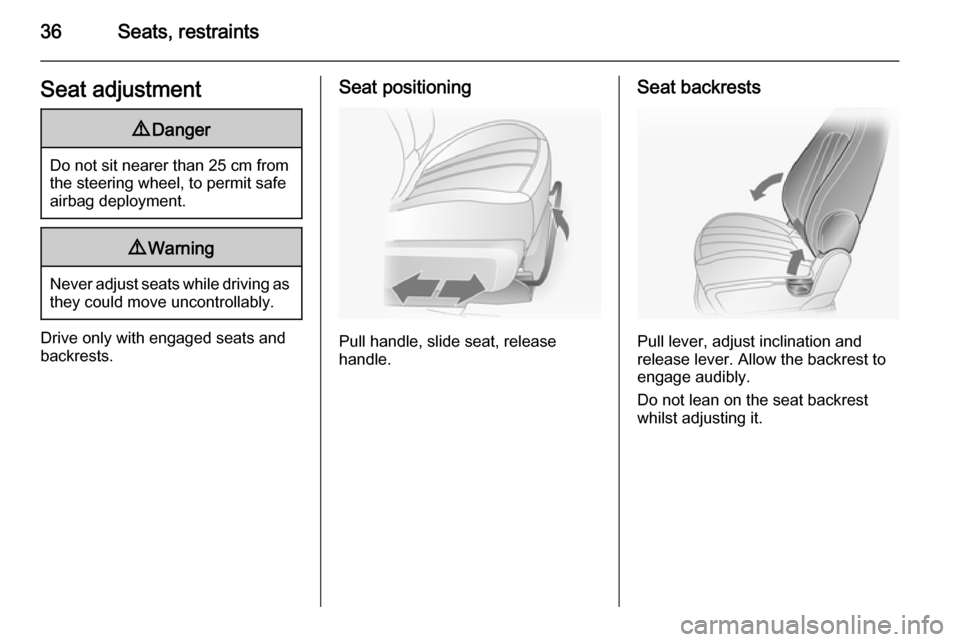
36Seats, restraintsSeat adjustment9Danger
Do not sit nearer than 25 cm from
the steering wheel, to permit safe
airbag deployment.
9 Warning
Never adjust seats while driving as
they could move uncontrollably.
Drive only with engaged seats and
backrests.
Seat positioning
Pull handle, slide seat, release
handle.
Seat backrests
Pull lever, adjust inclination and
release lever. Allow the backrest to
engage audibly.
Do not lean on the seat backrest
whilst adjusting it.
Page 40 of 223
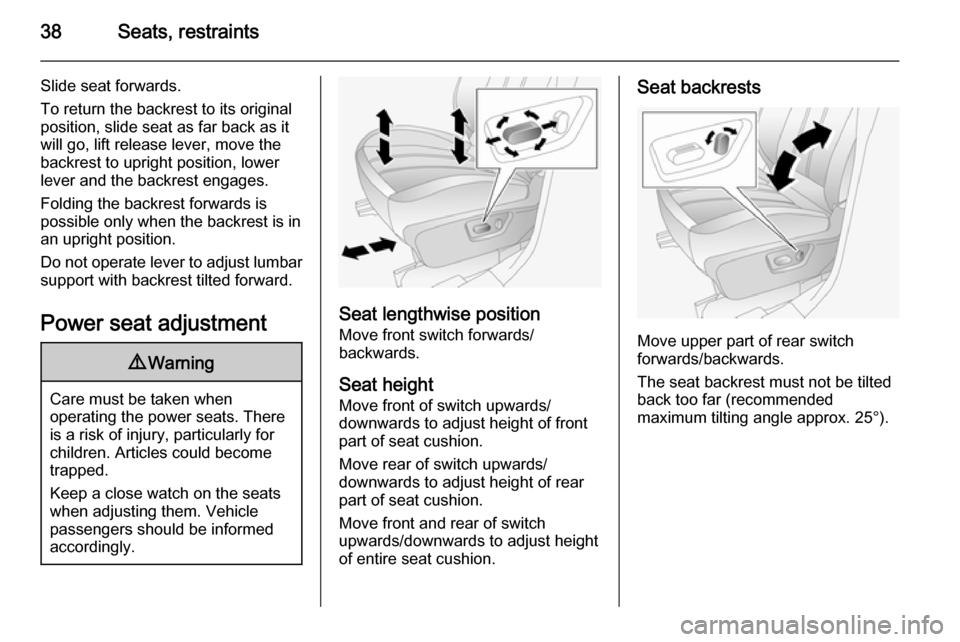
38Seats, restraints
Slide seat forwards.
To return the backrest to its original
position, slide seat as far back as it
will go, lift release lever, move the
backrest to upright position, lower
lever and the backrest engages.
Folding the backrest forwards is
possible only when the backrest is in
an upright position.
Do not operate lever to adjust lumbar support with backrest tilted forward.
Power seat adjustment9 Warning
Care must be taken when
operating the power seats. There
is a risk of injury, particularly for
children. Articles could become
trapped.
Keep a close watch on the seats
when adjusting them. Vehicle
passengers should be informed
accordingly.
Seat lengthwise position
Move front switch forwards/
backwards.
Seat height
Move front of switch upwards/
downwards to adjust height of front
part of seat cushion.
Move rear of switch upwards/
downwards to adjust height of rear
part of seat cushion.
Move front and rear of switch
upwards/downwards to adjust height
of entire seat cushion.
Seat backrests
Move upper part of rear switch
forwards/backwards.
The seat backrest must not be tilted
back too far (recommended
maximum tilting angle approx. 25°).
Page 42 of 223
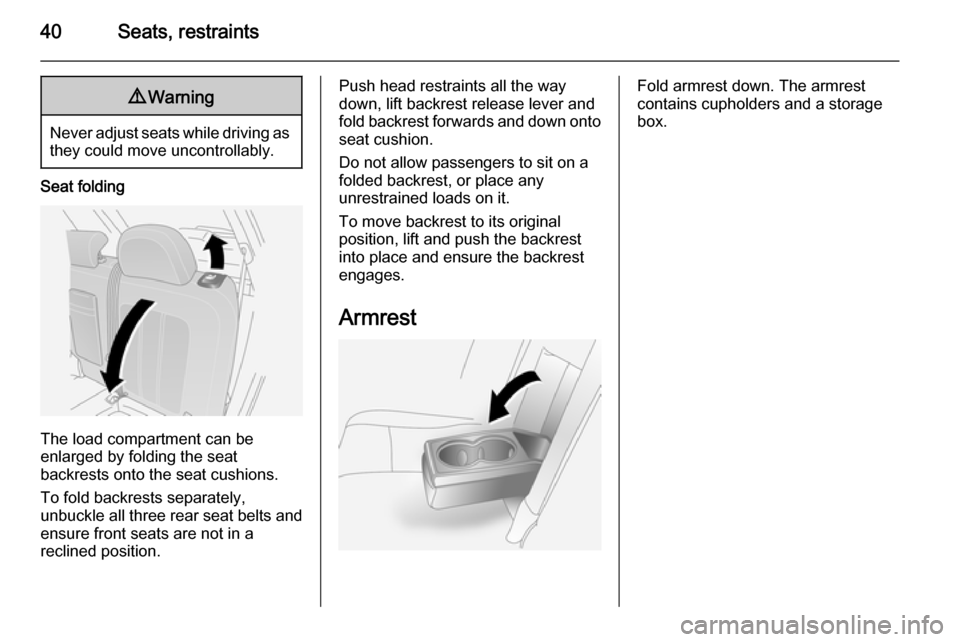
40Seats, restraints9Warning
Never adjust seats while driving as
they could move uncontrollably.
Seat folding
The load compartment can be
enlarged by folding the seat
backrests onto the seat cushions.
To fold backrests separately,
unbuckle all three rear seat belts and
ensure front seats are not in a
reclined position.
Push head restraints all the way
down, lift backrest release lever and fold backrest forwards and down onto seat cushion.
Do not allow passengers to sit on a
folded backrest, or place any
unrestrained loads on it.
To move backrest to its original
position, lift and push the backrest
into place and ensure the backrest
engages.
ArmrestFold armrest down. The armrest
contains cupholders and a storage
box.
Page 43 of 223
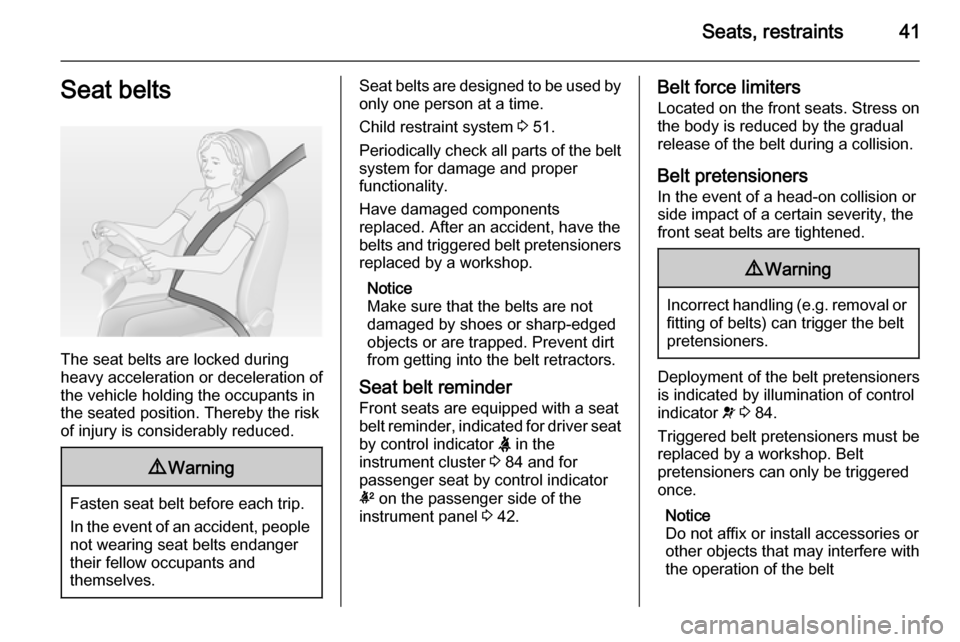
Seats, restraints41Seat belts
The seat belts are locked during
heavy acceleration or deceleration of
the vehicle holding the occupants in
the seated position. Thereby the risk
of injury is considerably reduced.
9 Warning
Fasten seat belt before each trip.
In the event of an accident, people
not wearing seat belts endanger their fellow occupants and
themselves.
Seat belts are designed to be used by only one person at a time.
Child restraint system 3 51.
Periodically check all parts of the belt
system for damage and proper
functionality.
Have damaged components
replaced. After an accident, have the
belts and triggered belt pretensioners replaced by a workshop.
Notice
Make sure that the belts are not
damaged by shoes or sharp-edged
objects or are trapped. Prevent dirt
from getting into the belt retractors.
Seat belt reminder Front seats are equipped with a seat
belt reminder, indicated for driver seat
by control indicator X in the
instrument cluster 3 84 and for
passenger seat by control indicator
k on the passenger side of the
instrument panel 3 42.Belt force limiters
Located on the front seats. Stress on
the body is reduced by the gradual
release of the belt during a collision.
Belt pretensionersIn the event of a head-on collision or
side impact of a certain severity, the
front seat belts are tightened.9 Warning
Incorrect handling (e.g. removal or
fitting of belts) can trigger the belt
pretensioners.
Deployment of the belt pretensioners
is indicated by illumination of control
indicator v 3 84.
Triggered belt pretensioners must be
replaced by a workshop. Belt
pretensioners can only be triggered
once.
Notice
Do not affix or install accessories or
other objects that may interfere with
the operation of the belt
Page 44 of 223

42Seats, restraints
pretensioners. Do not make any
modifications to belt pretensioner
components as this will invalidate
the vehicle type approval.
Three-point seat belt
Fastening
Withdraw the belt from the retractor,
guide it untwisted across the body
and insert the latch plate into the
buckle. Tighten the lap belt regularly
whilst driving by pulling the shoulder
belt.
Seat belt reminder X 3 84.
Loose or bulky clothing prevents the
belt from fitting snugly. Do not place
objects such as handbags or mobile
phones between the belt and your body.
9 Warning
The belt must not rest against hard
or fragile objects in the pockets of
your clothing.
Height adjustment
1. Squeeze release buttons together.
2. Slide adjuster up or down.
3. Ensure adjuster latches into position.